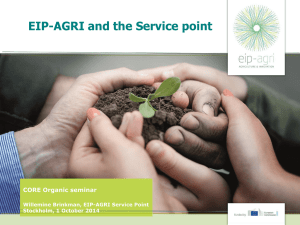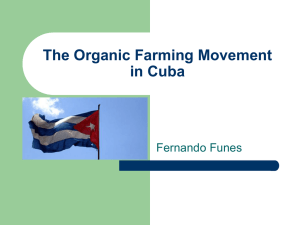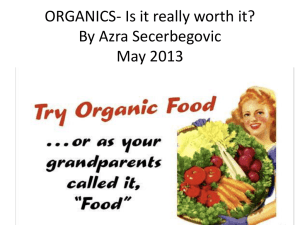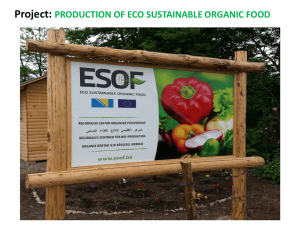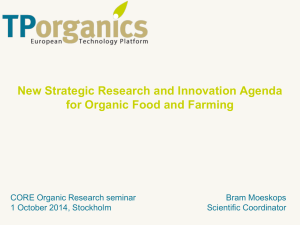Introduction to Organic Meat Goats and Lambs
advertisement
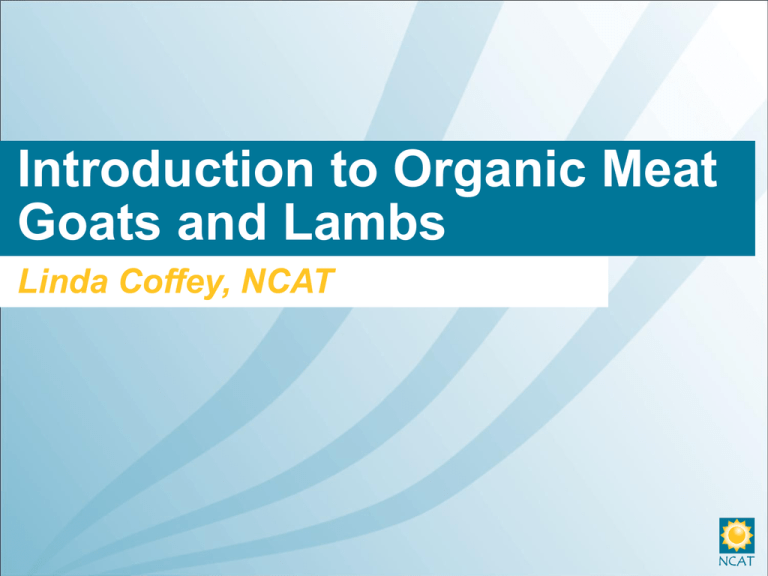
Introduction to Organic Meat Goats and Lambs Linda Coffey, NCAT Photo by Margo Hale My goal today: • Give each of you information about organic goat and lamb production and marketing • Point to further resources • Answer questions Now, a word from the audience: • What do you want to learn today? • What do you already know about “organics”? What is “organic”? • Is it the same as “natural”? • “Natural” has no official definition except “Minimally processed, no artificial ingredients, no preservatives.” (USDA) – No implants? – No chemicals? – Grass-fed? – Other? What does “organic” mean? • A production system that “respond[s] to site-specific conditions by integrating cultural, biological, and mechanical practices that foster cycling of resources, promote ecological balance, and conserve biodiversity” • A production system that meets all the requirements of the National Organic Program Regulations as defined in 7 CFR Part 205 What about organic goats and lambs? • Fed 100% organic feed • Not administered any synthetic medicines or hormones • Not factory farmed • Had access to fresh pasture or range (and grazed at least 120 days, getting 30% or more of nutrition from pasture during that time) • Meat was not irradiated • Raised by producer who is certified or registered with the state (registered if less than $5,000/yr) Why farm organically? • Organic agriculture is a soil-based system, placing emphasis on building the soil and encouraging health of soil, plants, animals, and people • Organic products sell for a premium to people who want to support the organic philosophy or are concerned about their health How do you get started? • Find a certifier • Learn the regulations • Write a plan for your farm that complies with regulations • Follow that plan and keep records to prove it (retain records 5 years) • Become certified ( 3-year transition period) • Be inspected annually Timeline for transitioning a ranch operation Land Prohibited materials last applied Organic Pasture/ Cropland 36 months Organic Slaughter Conception First 2/3 gestation Birth Last 1/3 gestation Animals Getting started • See ATTRA’s Guide to Organic Publications, especially “Organic Certification Process” publication • Visit the National Organic Program (NOP) web site • Read Langston University’s Organic Meat Goat Production module by Roger Merkel What needs to be certified? • Land—pasture & feed-producing cropland 3 years w/o prohibited substances • Animals organic management from last third of gestation • Production Facility contamination issues • Processing processing facility must be certified requires a separate application and plan Highly Recommended: Organic Livestock Documentation Forms https://attra.ncat.org/attrapub/summaries/summary.php?pub=171 ♦ inventory ♦ compost production ♦ breeding records ♦ sales ♦ ♦ outdoor access calendar ♦ pasture access calendar ♦ For a Print Copy Call: 1-800-346-9140 Highly Recommended: NCAT’s Guide for Organic Livestock Producers https://attra.ncat.org/attra-pub/summaries/summary.php?pub=154 For a Print Copy Call: 1-800-346-9140 Areas of consideration • • • • • Livestock origin Feed (100% organic) Health care PROCESSING Marketing Origin of slaughter livestock Livestock products that are to be sold, labeled, or represented as organic must be from livestock under continuous organic management from the last third of gestation… §205.236(a) Breeder…stock that has not been under continuous organic management since the last third of gestation may not be sold, labeled, or represented as organic slaughter stock §205.236(b)(2) Livestock feed • 100% Organic Feed Required • Feed Storage Must Ensure Organic Integrity • Feed Processing Must Ensure Organic Integrity Access to pasture rule • Animals must be on pasture grazing at least 120 days per year. • Minimum of an average of 30 percent dry matter intake during grazing season. • Year-round access to outdoors. Access to pasture rule Producers must: – have a pasture management plan: – manage pasture as a crop • to meet the feed requirements for the grazing animals and • to protect soil and water quality • See ATTRA’s “Pasture for Organic Ruminant Livestock” publication for full details and helpful worksheets; go to www.attra.ncat.org Pasture and range must be organic Bedding must be organic Health care for organic livestock: Prevention • Livestock Species & Type Selection [§205.238(a)(1)] • Adequate Nutrition [§205.238(a)(2)] • Appropriate Housing, Pasture, & Sanitation [§205.238(a)(3)] • Freedom of Movement; Stress Reduction [§205.238(a)(4)] • Appropriate Low Stress Physical Alterations [§205.238(a)(5)] • Vaccines & Veterinary Biologics [§205.238(a)(6)] Providing good nutrition and a low-stress environment $$$ Health care for organic livestock: Therapies, etc. • Natural Therapies (herbs, homeopathy, flower remedies, essential oils, acupuncture, radionics) • Synthetic Medications on the National List at §205.603 [§205.238(b)] • Nonsynthetic Pest Controls (traps, botanicals, biologicals, minerals) • Synthetic Parasiticides on the National List at §205.603(13) [§205.238(b)] Synthetic parasiticides • Ivermectin, currently on the National List §205.603(13), however: prohibited in organic slaughter stock allowed in breeder stock but prohibited during last third of gestation Lactation (so, during the times of most need-- in lambs or kids and during periparturient rise and early lactation--you can’t use it) • The producer of an organic livestock operation must not [w]ithhold treatment from a sick animal in an effort to preserve its organic status. All appropriate medications must be used to restore an animal to health when methods acceptable to organic production fail. • Livestock treated with a prohibited substance must be clearly identified and shall not be sold, labeled, or represented as organically produced. –§205.238(c)(7) Livestock recordkeeping • Verification of organic status for new animals • Herd/flock health records • Vaccination & medication labels • Breeding records • Slaughter & processing records • Grazing and pasture records • Feeding records • Sales records If you want to raise organic goats or lambs: • Learn about the certification process • Investigate the market; can you sell organic goats or lambs for a premium? • FIND A PROCESSOR (certified organic); this may be very difficult • Learn all you can about managing grazing so that nutrition and health are optimal • Find a source of organic feed (your farm or outside) If you want to raise organic goats or lambs, continued: • Get your pastures certified (must be free from prohibited substances for 3 years) • Keep excellent records of everything; you are required to plan and to show you follow the plan to farm organically, so-• Learn what is allowed and what is not • Get all the help you can from ATTRA materials (see list provided) Highly recommended: • NCAT’s Guide for Organic Livestock Producers, https://attra.ncat.org/attra-pub/ summaries/summary.php?pub=154 • For a print copy call: 1-800-346-9140 Highly recommended: • Langston University’s web-based goat production course includes a module about organic meat goat production (also relevant for lamb producers): • www.luresext.edu/goats/training/qa.html and “browse” and select chapter • Don’t miss Assignment 2, page 9! • ATTRA National Sustainable Agriculture Information Service • www.attra.ncat.org • 800-346-9140 The National Center for Appropriate Technology (NCAT) is a nonprofit organization that helps people and communities. NCAT champions smallscale, sustainable and local solutions to reduce poverty, protect communities and promote natural resources. Since 1976, NCAT has weatherized houses, trained farmers, monitored energy use and demonstrated renewable technology. NCAT works on local and national projects that foster a healthy quality of life for everyone.




